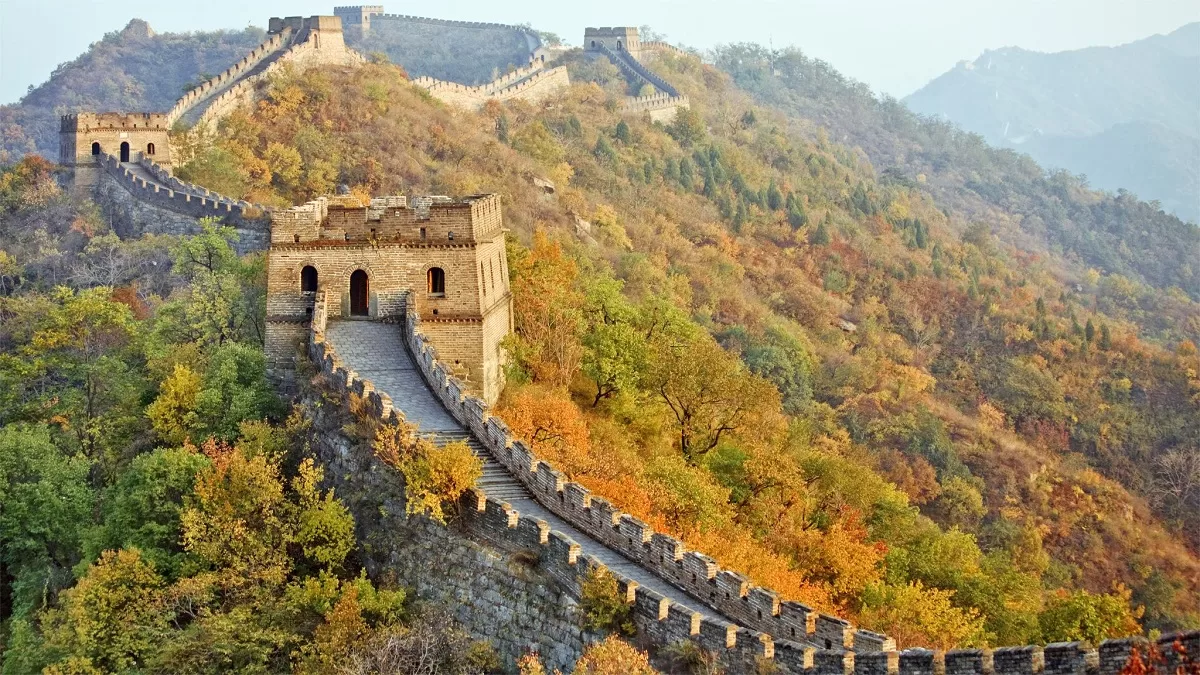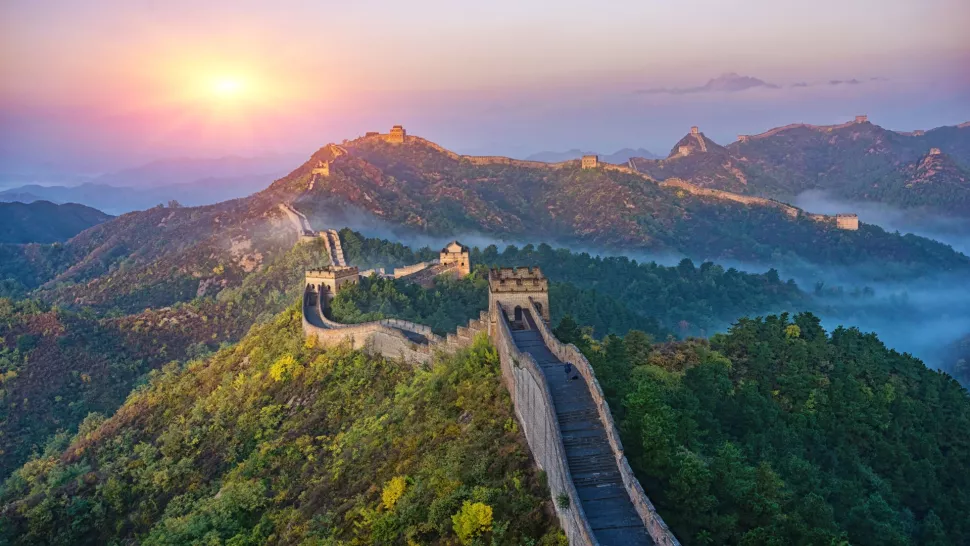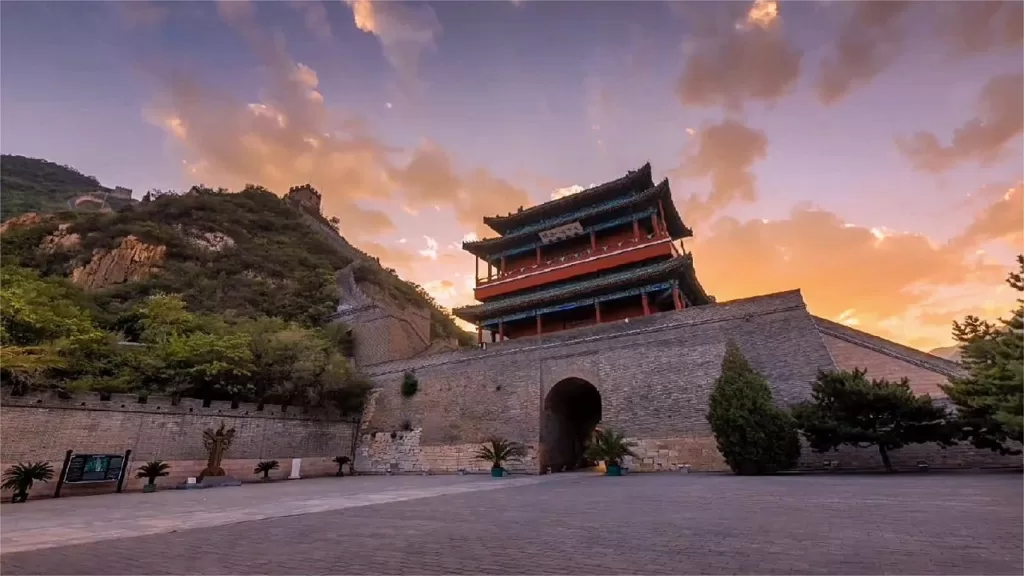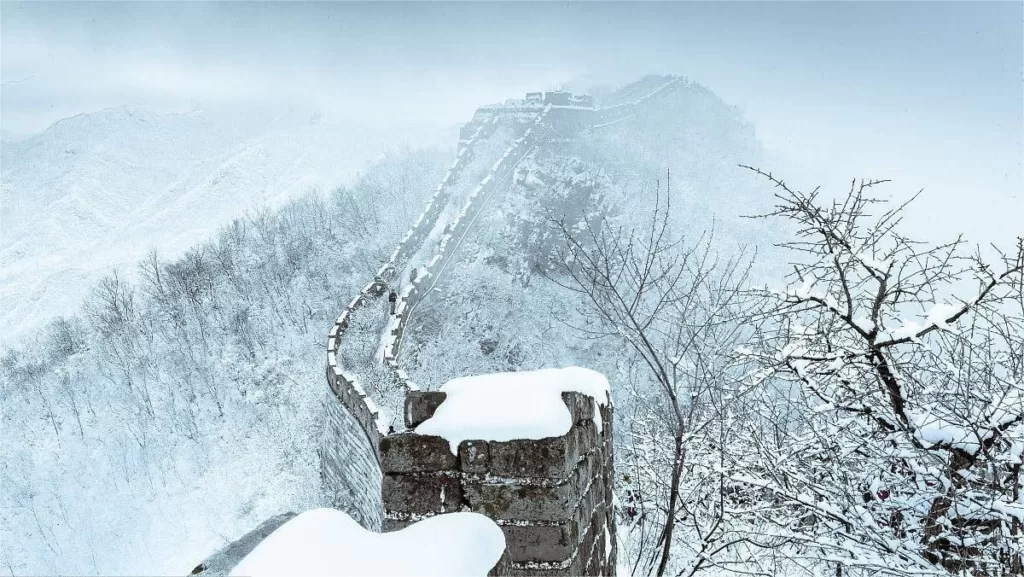Mutianyu Great Wall (慕田峪长城), located in Huairou District, northeast of Beijing, connects to Juyongguan in Changping District and Gubeikou in Miyun District. It was initially constructed during the Northern Qi Dynasty (550-577 AD) and was later rebuilt by General Xu Da in the early Ming Dynasty on the foundations of the Northern Qi Great Wall. Due to its strategic location, Mutianyu has historically been a critical military stronghold for defending Beijing, witnessing numerous battles, particularly during the Ming Dynasty.
In the second year of the Yongle Emperor’s reign (1404 AD), a major pass was established here, with the Great Wall being constructed on the high mountains. The pass was originally named Motianyu Pass, meaning “Sky-reaching Valley,” because looking up from the valley, the wall seemed to touch the sky. The name later evolved to Mutianyu Pass due to the phonetic similarity between “Motian” and “Mutian” and the interchangeable use of the characters “峪” (valley) and “谷” (valley). By the late Ming Dynasty, families with surnames such as He, Wang, and Yang began to settle in the area, forming a village named after the pass.
The Great Wall at Mutianyu is built with Hua Mountain rock and lime, featuring dense watchtowers and dual battlements. The wall is fortified with Ming Dynasty cannons, and the double parapets have square openings under the battlements, designed in a curved top shape. These openings were strategically built to facilitate the defenders in attacking enemies while providing protection for themselves. Today, Mutianyu is renowned for its well-preserved architecture and stunning mountainous scenery, making it a popular destination for visitors seeking to experience the grandeur of the Great Wall.
Table of Contents
- Basic Informaiton
- Location and Transportation
- Highlights of Mutianyu Great Wall
- Nighttime Tour at Mutianyu Great Wall
- Map and Recommended Routes
- Best Time to Visit Mutianyu Great Wall
- Photography Tips at Mutianyu Great Wall
- Restaurants at Mutianyu Great Wall
- Vlog about Mutianyu Great Wall
- Useful Tips Summarized from Reviews
- Other Sections of Great Wall in Beijing
- Explore Beijing Like A Local
Basic Informaiton
| Website | https://www.mutianyugreatwall.com/ |
| Estimated Length of Tour | Over 3 hours |
| Opening Hours | 9.00 – 16.30; Last entry: 15.30 (14th Novermber – 15th March the next year) 7.30 -18.00; Last entry: 17.00 (From Monday to Friday, 16th March – 13th November) 7.30 – 18.30; Last entry: 17.30 (Saturday and Sunday, 16th March – 13th November) |
| Admission Ticket | Adut: 45 yuan Children under 6 years old or below 1.2 meters: free |
| Shuttle Bus | One-Way: 10 yuan Round: 15 yuan |
| Cable Car | One-Way: 100 yuan Round: 140 yuan |
| Toboggan Rides | One-Way: 100 yuan Cable Car & Toboggan Rides: 140 yuan |
| Telephone Number | 0086-010-61626022 |
Location and Transportation
Mutianyu is a section of the Great Wall of China, located in Huairou District, about 70 kilometers (43 miles) northeast of central Beijing. The location is easily accessible by public transportation or private car, and is open to visitors year-round.
| Transportation Method | Departure Point | Schedule | Ticket Price | Notes |
|---|---|---|---|---|
| Bus No. 916 Express + Local Bus | Dongzhimen Stop -> Transfer at Huairou Beidajie Stop | Varies with bus schedules | Regular bus fare | Transfer to H23, H24, H35, or H36 at Huairou Beidajie Stop; get off at Mutianyu Huandao Stop |
| Mutianyu Direct Bus Line | Dongzhimen Wai Bus Station | Departs at 8:30 AM; Returns at 4:00 PM (Sat & Sun only) | 30 yuan (one way); cash on board | 1 hour 40 minutes ride; tickets on sale half an hour in advance; call 96166 for inquiries |
| Tourist Special Bus | Qianmen Distribution Center, Qianmen Street North | Departure: 8:00 – 10:00 AM; Return: 13:00, 14:30, 16:00 | Check with Qianmen Distribution Center | On-site ticket sales or via WeChat; call 010-83531111 |
| MUBUS | Swiss Apartment gate (near Starbucks) | 8:00 AM, 10:00 AM | Check Mobus official website or WeChat | Book tickets online; call 4006603560 |
| BUSDA | Heping Xiqiao Subway Station, Exit B | 8:00 AM, 9:00 AM, 10:00 AM, 12:00 PM | Adults: 80 yuan; Free for 0-3 years old; Half price for 4-10 years old | 5-hour visit; call 13051039503 |
| Taxi | Major hotels, tourist spots, or flag down on the street | Anytime | 300-500 RMB one way | 1.5 hours ride; ensure meter is used or agree on fare; show driver “慕田峪长城” |
Highlights of Mutianyu Great Wall
Battlements and Branch Cities

One of the unique architectural features of Mutianyu Great Wall is its battlements, which are not the typical rectangular openings but instead resemble jagged saw teeth. The arrow holes, positioned below the battlements, are square with curved tops, a design that facilitates better defense and protection for the soldiers. Strategically critical sections of the wall are fortified with watchtowers and, in some places, with cannon platforms.
Mutianyu is also notable for its “branch cities” or secondary walls. These are additional segments of the Great Wall that extend off the main wall along high ridges, adding another layer of defense. These branch walls vary in length from a few meters to several dozen meters and often include their own watchtowers.
Dense Watchtowers

The density of watchtowers at Mutianyu is remarkable. From the first watchtower (Dajiao Lou) to the fourth (Zhengguan Tai), there are four watchtowers within a span of less than 500 meters. Extending from the first to the twentieth watchtower over a length of just 3,000 meters, there are 25 defensive structures, including watchtowers, signal towers, and ramparts. This high concentration of defensive structures is uncommon among other sections of the Great Wall.
A distinctive feature of the Mutianyu section is the presence of double-sided battlements. While most sections of the Great Wall have battlements only on the outer side, Mutianyu has them on both sides. These double-sided battlements serve as protective barriers for soldiers fighting enemies on either side, underscoring the strategic significance of Mutianyu in history.
Three Dimensional and Dynamic Landscape

The Mutianyu Great Wall is renowned for its three-dimensional and dynamic landscape. The Mutianyu Pass, at an elevation of 486 meters, is the lowest point. Moving eastward, the elevation rises sharply by 117 meters over a distance of less than 500 meters to reach the Dajiao Lou (Watchtower 1). To the west, from the Zhengguan Tai (Watchtower 4) to Watchtower 19, the terrain is relatively smooth and less steep. However, from Watchtower 20 to the highest point at Niujiaobian, the elevation increases dramatically by 533 meters over the course of approximately ten watchtowers, reaching an impressive 1,039 meters. This significant elevation change makes the wall visually spectacular.
Cable Car and Speed Slide

Mutianyu Great Wall is equipped with comprehensive tourist facilities. The scenic area includes a cable car, which spans 723 meters and reaches an elevation of 640 meters at its highest point. The cable car has a capacity of transporting 1,800 people per hour in one direction, making access to the wall convenient and efficient.
Another notable feature is the Speed Slide, also known as the “dry land toboggan.” This slide combines both sports and entertainment, stretching 1,580 meters in length with a top speed of 30 kilometers per hour. This thrilling ride provides a fun and exhilarating way to descend from the Great Wall.
China Dream Stone City

At the foot of the wall is the China Dream Stone City, covering an area of 33,000 square meters. This site houses over 20,000 unique stones collected from across China. These stones are displayed in three natural scenic areas: the Mutianyu Waterfall Cave, the Peculiar Stone Garden, and the Stone Spectacle Hall. This attraction offers visitors an additional cultural experience and a chance to appreciate the natural beauty of rare stones.
Nighttime Tour at Mutianyu Great Wall
| Details | Information |
|---|---|
| Duration | July 1st – August 31st |
| Operating Hours | 17:30 – 21:30 |
| Ticket Price | 200 RMB |
| Inclusions | – Round-trip shuttle bus tickets – Round-trip cable car tickets – Night admission (Children under 120cm enter free) |
| Ticket Purchase Deadline | 20:00 |
| Accessible Sections | Towers 10 to 15 |
| Special Features | Live band performances at the 14th Tower Cable Car Platform |
| Facilities | – Great Wall Hotel: BBQ and beer for dinner – Restaurants and cultural shops: Open until 21:30 |
| Daytime Operating Hours | 07:00 – 17:00 (ticket sales stop at 17:00) |
| Nighttime Check-in Time | 17:30 – 20:30 |
Map and Recommended Routes

1. Cable Car + Hiking Route
- Start: Enter through the North Ticket Gate.
- Ascend: Take the cable car up to Tower 14.
- Hiking: Begin hiking westward from Tower 14, continuing until you reach the highest point at Tower 20.
- Return: After exploring Tower 20, hike back to Tower 14.
- Descend: Take the cable car down to complete your visit.
This route combines the ease of the cable car with a rewarding hike, offering beautiful views of the Great Wall. The hiking segment is mostly flat, making it suitable for most visitors.
2. Eastern Line Tour
- Start: Enter through the South Ticket Gate.
- Ascend: Take the chairlift up to Tower 6.
- Hiking: From Tower 6, hike eastward to visit Zhengguan Terrace, then continue to Tower 1 (Dajiaolou).
- Return: Hike back to Tower 6.
- Descend: Take the toboggan down to complete your visit.
This route is ideal for those who want to experience the toboggan ride and visit Zhengguan Terrace. Although it requires a return hike to Tower 6, the overall journey is relatively easy.
3. Central Line Tour
- Start: Enter through the North Ticket Gate.
- Ascend: Take the cable car up to Tower 14.
- Hiking: Hike eastward from Tower 14 to Tower 6.
- Descend: Take the toboggan down from Tower 6 to complete your visit.
This route allows visitors to enjoy both the cable car and the toboggan while taking in scenic views of the Great Wall. The need to control the toboggan descent might make this route less suitable for elderly visitors.
4. Full Hiking Route
- Start: Enter through the scenic area entrance and head northeast towards Tower 1.
- Hiking: Continue hiking from Tower 1 all the way to Tower 20. If not visiting Zhengguan Terrace, hike from Tower 6 up to Tower 14.
This route is perfect for those who want a complete hiking experience on the Great Wall. It offers an extensive trek across various towers, providing a comprehensive view of this magnificent structure.
Best Time to Visit Mutianyu Great Wall
The best times to visit the Mutianyu Great Wall are spring (March to May) and autumn (September to November).
In spring, the Great Wall is surrounded by fresh green foliage and blooming flowers, creating a lively and vibrant atmosphere. It’s also the time for the Peach Blossom Festival, adding a touch of local charm to your visit. The pleasant weather makes it perfect for hiking and exploring the ancient wall.
Autumn is considered the most beautiful time to visit. The wall is adorned with colorful autumn leaves, offering a breathtaking and picturesque view. The cool, comfortable temperatures are ideal for outdoor activities, making it a great season for both sightseeing and photography.
Photography Tips at Mutianyu Great Wall
Low Angle Shot with Leaning Pose:
- Technique: Photographer crouches down and shoots upwards with the model leaning forward.
- Composition: Use the rule of thirds grid, placing the model in the lower-middle two squares. The model should close their eyes and enjoy the breeze.
- Background: Capture the autumn foliage in the background.
Over-the-Shoulder Look:
- Technique: Photographer stands 2 meters away from the model and holds the camera vertically.
- Composition: Position the model in the lower-middle two squares of the grid. Have someone call the model’s name so they turn their head back over their shoulder.
Stairway Sit:
- Technique: Model sits on the stairs while the photographer is positioned at the bottom, using a 0.5x wide-angle lens.
- Composition: Frame the shot so the model’s feet are at the edge of the frame, capturing an upward view.
Focused Enemy Tower Shot:
- Technique: Zoom in to 2x and position the camera vertically.
- Composition: Use the grid to place the model in the lower-middle section, with the enemy tower centered in the background.
Looking Up from Below:
- Technique: Model stands below the enemy tower while the photographer is on the stairs above.
- Composition: Place the model in the lower-right four squares of the grid. Have someone at the top of the stairs call the model’s name to make them look up.
Restaurants at Mutianyu Great Wall
| Restaurant | Type of Cuisine | Description |
|---|---|---|
| Burger King | Fast Food / Western | Offers burgers, fries, and other fast food options. A familiar choice for quick meals. |
| Xian Laoman (馅老满) | Chinese / Dumplings | Serves homestyle dishes including large dumplings and savory pies. |
| Dajia Le Kitchen (大家乐厨房) | Chinese / Noodles | Specializes in hand-cut noodles and traditional Chinese dishes. |
| Lao Lishu (老栗树) | Mixed Cuisine / Café | A combination of Western and Chinese dishes with a bar and coffee options. |
| Kaledisi (卡乐滋) | Fast Food / Western | Features rice dishes, burgers, and other simple, quick meals. |
| Tianyuan Tea Restaurant (田缘茶餐厅) | Café / Sandwiches | Offers sandwiches, coffee, and light meals in a relaxed setting. |
| Vegetarian Café (素食坊) | Vegetarian / Healthy | Serves creative and healthy vegetarian dishes. |
| Old Beijing Zha Jiang Mian Noodle House (老北京炸酱面馆) | Chinese / Noodles | Offers traditional Beijing-style noodle dishes with a variety of toppings. |
| Yisong Lou Restaurant (翼松楼餐厅) | Chinese / Traditional | Located at the cable car entrance with good views and a range of Chinese dishes. |
| Subway | Fast Food / Western | Offers sandwiches, burgers, and quick meals in a familiar fast-food setting. |
Vlog about Mutianyu Great Wall
Useful Tips Summarized from Reviews
Enjoy the Toboggan Slide: The toboggan slide at Mutianyu Great Wall is quite long and very popular among children. If the queue isn’t too long, it’s recommended to include this activity in your itinerary.
Take the Cable Car to Towers 14-20: The cable car ride and the corresponding towers (14-20) are considered the highlights of Mutianyu Great Wall. They offer stunning views and are worth experiencing.
Convenient Transportation: To reach Mutianyu Great Wall, you can take a direct shuttle bus from the Arrow Tower at Qianmen (前门). This shuttle service is provided by the Beijing Tourism Distribution Center and costs around 80 RMB for a round trip, including transportation within the scenic area. It’s a time-saving and convenient option.
Accommodation Options: There are several guesthouses located halfway up the mountain on the way to Mutianyu. Additionally, there’s a hotel near the entrance of the scenic area. However, some visitors find the hotel’s facilities to be average.
Prioritize Safety: Be cautious and prioritize safety during your visit. The steps on the Great Wall can be steep, some even close to a 90-degree angle. Take your time and watch your step to prevent accidents.









We set off from the city center at 8 AM and took our time along the way, finally arriving at the foot of the Mutianyu Great Wall before noon. We took the cable car to the 14th watchtower and walked, stopped, and enjoyed the scenery while taking photos. Eventually, we reached the 20th watchtower. There were so many people, especially when we queued at the 20th watchtower; the line was quite long. Getting to the top was not easy, and… Read more »
First, about transportation, we bought round-trip bus tickets for 80 RMB at the Qianmen Street. We had to go to a designated departure point to catch the bus, and it took about 1.5 hours to reach the foot of the Great Wall, which felt quite fast. On the bus, the tour guide helps us with buying entrance tickets and cable car tickets, with the entrance ticket costing 40 RMB. We chose the cable car up for 100 RMB and the… Read more »
I reached the top of Mutianyu at 6:30 in the morning to watch the sunrise. It was so beautiful. Because I arrived early, there was no one else around for two whole hours, allowing me to enjoy the views of the Great Wall all by myself.